Your cart is currently empty!
Pottery Wheel for Beginners – 14 Tips on Buying a Wheel
Published:
Last Updated:
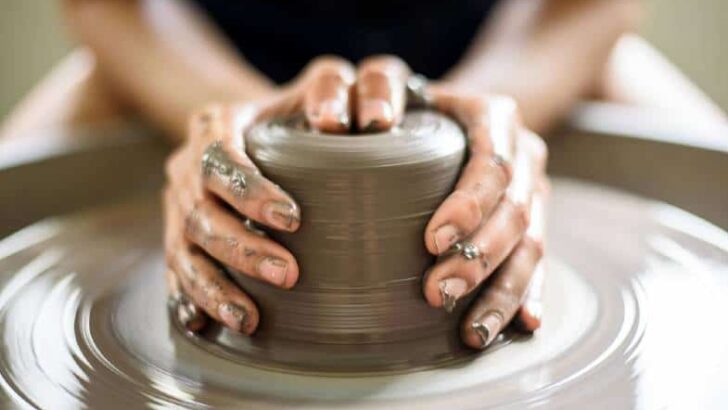
Affiliate Disclaimer
As an affiliate, we may earn a commission from qualifying purchases. We get commissions for purchases made through links on this website from Amazon and other third parties.
Buying a pottery wheel is very exciting, but it can be scary too. There are a lot of pottery wheels to choose from, and if you’re a beginner it can be hard to know which will suit you best. So, which is the best pottery wheel for beginners?
In this article, I will outline 14 tips on choosing exactly the right pottery wheel for you. I will then review 4 of the best pottery wheels for beginners, and look at how each of them compares.
Hopefully, in the end, you will feel in a better position to choose the best pottery wheel for you.
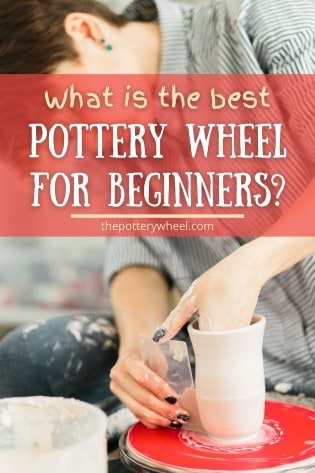
Choosing the Best Pottery Wheel for Beginners
Here are 14 top tips on buying your first pottery wheel….
Tip 1) How Big is the Wheel and How Much Space Do You Have?
You may be lucky and have a lot of space to make pottery. If you do have lots of space, then this factor may not be much of a consideration for you. However, if like many people, you don’t have a lot of extra space, then it’s important to factor in the size of a pottery wheel.
Pottery wheels come in all sorts of shapes and sizes. Some are very compact and can be tidied away into a corner or cupboard when you are not using them. Others are quite big, chunky, and harder to store when not in use.
Potters who have been using a wheel for a long time will often have a dedicated space to make pottery. Even if this space is a corner of the garage, basement, or spare room.
But when you are buying your first wheel, it’s unlikely that you will have a setup like this. You need your pottery wheel to fit into your lifestyle and your space. And there are some pottery wheels on the market that can be stored easily between use.
This compact pottery wheel by Vevor can be stored easily when it is not in use. My small dog (Archie!) is a good measure of scale.
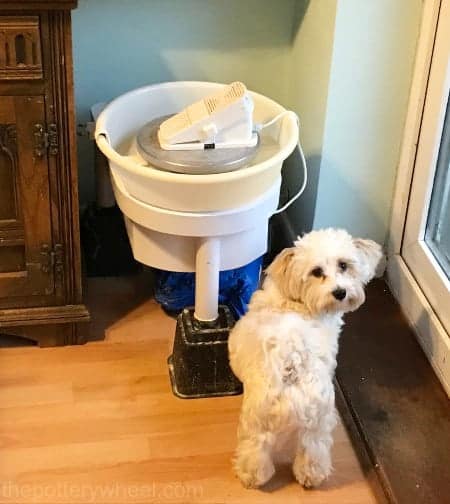
So, when you are choosing your wheel, it’s a good idea to look at the overall dimensions. That is the length, width, and height of the pottery wheel.
This might sound like a strange thing to consider. However, if you are planning to move your pottery wheel between pottery sessions, then its weight is an important factor.
Really this tip boils down to how portable the pottery wheel is. Are you going to be able to move the wheel around easily? Can you slide it across the floor or lift it? Or is it so heavy that once it’s in place it’s going to be hard to budge?
Tip 3) Tabletop or Free-Standing Wheel?
A related question is whether you want to buy a free-standing wheel or a tabletop pottery wheel.
Free-Standing Wheels
Free-standing wheels have 3 legs that are designed to be positioned on the floor. The potter then sits by the wheel, with knees on either side of the wheel as they throw their pots.
Some free-standing wheels will have legs that are adjustable in length. It is also sometimes possible to buy leg extenders or ‘booties’ that fit over the end of the legs on the wheel. This can also give you some flexibility around the height of the wheel.
Table Top Pottery Wheels
A tabletop pottery wheel is, as the name suggests, designed to go on a table. Tabletop pottery wheels don’t have permanently attached legs. They have a flush base, with rubber gaskets to help stop it from sliding across the table when it’s being used.
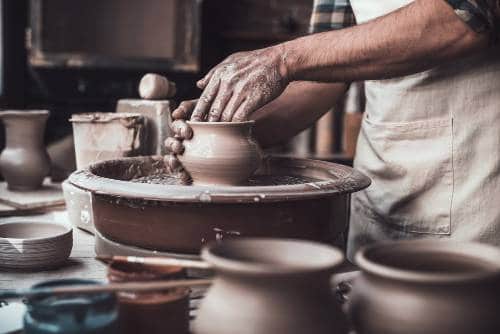
Potters have different preferences over what height to have their potter’s wheel. However, in general, it’s recommended that your butt is just a little bit higher than the wheel head. The wheel head is the circular disc that the clay sits on when you are throwing.
When your wheel is at this height, you need to hinge forward from your hips to shape the clay.
So, if you get a tabletop wheel, you will also need to have a low table to put the pottery wheel on. Alternatively, you can position it on a higher table and throw your pots whilst standing up. One advantage of standing whilst you throw is that it can be better for your back.
Optional Legs
Some tabletop wheels have optional legs that can be attached to the wheel. This gives you the option of using the wheel as a free-standing wheel too.
Free-standing or Table Top Pottery Wheel – Which Suits You Best?
It’s good to be aware that some wheels are designed to be used on a tabletop. I’ve noticed that sometimes manufacturers and retailers don’t make it especially clear when a pottery wheel is designed to be used on a tabletop.
This is especially true when retailers are selling unbranded wheels that are very competitively priced. It’s worth checking this out before you buy your wheel.
Otherwise, you might end up with a pottery wheel that is designed to be used as a tabletop wheel, when actually you wanted to buy a free-standing wheel.
One of the advantages of a tabletop pottery wheel is that they are very portable. You can move it from room to room, you can use it to demonstrate the potter’s wheel when you are out and about. You can even take it on holiday with you if you can’t bear to be parted from your wheel.

In addition to being portable, a well-made tabletop potter’s wheel will be as strong and sturdy as a free-standing wheel. So, if flexibility is what you are after, a tabletop potter’s wheel might be right for you.
Two of the best tabletop pottery wheels are the Shimpo Aspire and the Speedball Artista. If you are thinking about buying a tabletop wheel, you might want to check out my in-depth article comparing the two.
Tip 4) Check Out the Wheel Head
As stated above, the wheel head on a potter’s wheel is the disc that the clay sits on when the pot is being formed. The standard size for a wheel head is 14”, however, some potter’s wheels will have smaller wheel heads.
Some potter’s thrown directly onto the wheel head. However, it is handy to be able to throw onto something called a pottery bat. A bat is a disc that is usually made out of wood or plastic, which attaches to the wheel head.
When using a potter’s bat, when you have finished making your piece, you can lift the bat off the wheel head. The bat and the pot can then be set aside to dry.
This is handy as it helps you avoid having to lift the pot off the wheel head when the clay is still soft and wet.
Tip 5) Look Out for Bat Pins
Pottery bats are usually secured to the wheel head using bat pins. Bat pins are metal pins that screw into holes on the wheel head. The metal pins then fit into holes on the underside of the bat. Once the bat is clicked into place, you can throw it onto the bat, and lift the whole bat off when you’re done.
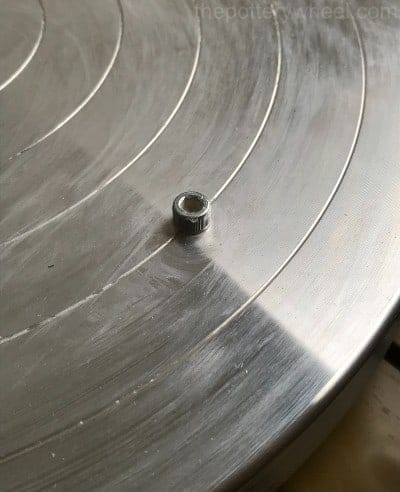
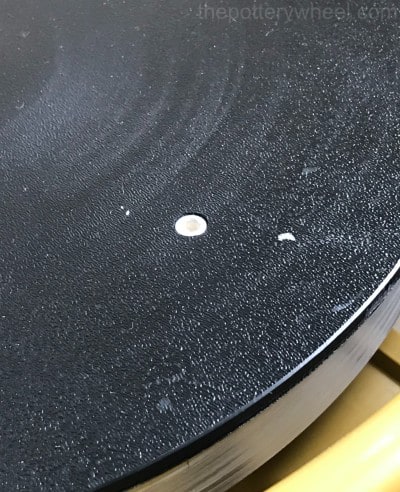
Most wheel heads are 14” and they have bat holes/pins that are 10” apart.
Some wheel heads are smaller than the standard 14”. However, what is more, important is the size of the bat that is attached to the wheel head. For example, you can fit a 14” or 16” pottery bat on a 12” wheel head.
The type of pottery bat that you can use depends on how far apart the bat pins are on the wheel head. Most of the time the holes for the bat pins are 10” apart.
However, sometimes they are closer together than this. For example, the bat pin distance on a Shimpo Aspire is 6”. So, you’d need to buy pottery bats that fit that particular model.
Fortunately, there are lots of different makes of pottery bat on the market. So, you will find the right pottery bat for your wheel. It’s just something to be aware of when you buy your wheel.
No Bat Holes? No Problem!
Not all wheel heads have bat pins. Some older-style potter’s wheels don’t have bat pins. So, if you are buying a used, or vintage wheel then it may not have bat pins. Also, many of the more competitively priced, unbranded potters wheels made today don’t have bat pins.
It isn’t a problem if you buy a potter’s wheel that does not have bat pins. Although it can be a bit fiddly to learn, there is a knack for removing pots directly from the wheel head.
Also, there are other ways to attach pottery bats directly to a wheel head without bat pins. One method that potters use is to flatten a small amount of clay onto the wheel head. The pottery bat is then pushed firmly onto the flattened clay. The clay acts as an adhesive and creates a suction that keeps the bat in place as you throw.
Another way to keep a pottery bat in place is to use an Xiem BatMate. These are thin circles of sponge-like fabric. The fabric is wetted and wrung out and then put onto the wheel head. The bat is then pressed onto the wet Bat Mate, which creates suction. As a result, the bat stays firmly in place as you throw.
Tip 6) Foot Pedal or Hand Lever?
Some potter’s wheels are designed to be operated by hand. They may have a lever or a toggle located on the side of the body of the wheel. The lever will adjust the speed of the wheel head.
Some potters prefer to operate the speed with a lever. And lever-controlled wheel can be good for wheelchair users.
Other wheels are operated by a foot pedal, with the potter adjusting the speed of the wheel with their foot.
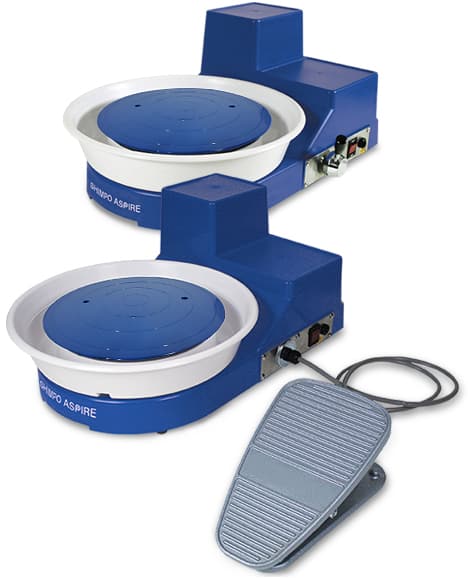
The image above, is of the Shimpo Aspire tabletop wheel. The wheel at the back is controlled by a hand operated lever. Where as the wheel at the front is operated by a foot pedal.
There are also wheels that can be operated either by hand or by foot pedal. Sometimes there is an option to plug in a foot pedal, to override the hand lever function.
Before you buy a wheel, it’s a good idea to double-check how the speed is controlled. If you’ve been taking a local pottery class, you may have become used to using a foot pedal. Adjusting to a hand lever might feel a bit awkward.
Tip 7) Does it Have a Reverse Switch?
A lot of pottery wheels have a switch so you can change the direction that the wheel head turns.
It’s generally said that right-handed potters find it easier to throw with the wheel turning counter-clockwise. And that left-handed people find it easier with the wheel turning clockwise.
However, as with all generalizations, there are always exceptions. All though this is the convention, there is no rule to say that you should have the wheel going in one direction rather than another.
In fact, it’s best to throw with the wheel turning in whatever direction feels most natural to you.
A reverse function on a wheel is handy. This is because there are times when you might want to switch directions. For example, some potters throw with the wheel turning counterclockwise and trim their pots with the wheel going clockwise.
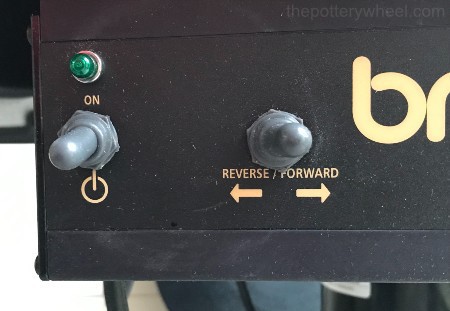
However, not having a reverse switch on a potter’s wheel needn’t be a deal-breaker. And most potters rarely use the reverse switch.
If a particular model doesn’t have a reverse switch, you will be able to buy a left or right-handed version at the point of sale.
Tip 8) The Splash Pan
The splash pan on a potter’s wheel is the circular tray that goes around the wheel head. It’s a container that is designed to catch water, slip, and clay trimmings as you throw. These days they are usually made of plastic.
Splash pans can get messy. In fact, their job is mainly to collect the mess as you throw your pots. So, a good splash pan is one that is easy to clean.
Usually, when beginner potters are learning how to throw, they use a lot of water. This creates a lot of clay slip, and the splash pan normally needs a good clean after throwing.
So, the best pottery wheel for beginners has a splash pan that is easy to remove and clean.
Most splash pans are made in two parts. They click together and can be easily unclicked to remove and clean them. Some splash pans are one piece and are removed by lifting them off over the wheel head shaft when the wheel head has been removed.
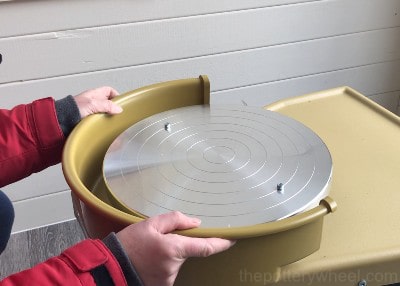
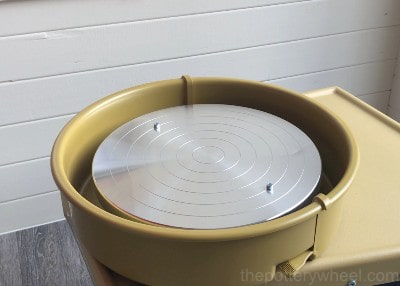
It’s a personal preference which you like best. However, in my experience, the splash pans on cheaper wheels tend to break quite easily.
Sometimes the lugs that click together are made of cheaper brittle plastic and don’t fit well together. With time the plastic becomes weakened and they can crack.
Tip 9) Speed is Important but Not as Important as Power
Usually, the speed at which a pottery wheel spins is part of the manufacturer’s specification. This is measured in RPM or revolutions per minute, basically, how many times the wheel rotates per minute.
Potters like to throw at different speeds, and it’s important to be able to vary the speed of the wheel as you throw. However, the difference between a wheel that spins at 230 and 250 rpm is not that important.
And rotating fast is not necessarily the same as being powerful. Something can spin fast until you start to apply pressure to it. What is more important with a pottery wheel is how powerful the motor is, and how much torque it has. This brings me to the 10th tip about motor power.
Tip 10) Check out the Power of the Motor
Electric pottery wheels are driven by a motor and motors have more or less power. The power of a pottery wheel motor is usually measured in HP (horsepower).
Motors for pottery wheels range in power from ¼ hp to 1 ½ hp. A pottery wheel needs a strong motor. This is because there are forces working against the motor as you form your pots. For a start, the motor has to cope with the weight of the clay. But also, as you shape the clay, your hands and body weight create a force against the action of the motor.
So, the motor on a pottery wheel has to cope with weight and resistance. Stronger motors will be able to handle heavier weights of clay and they will have more torque. Torque is the force at which the wheel head rotates around the shaft on which it’s mounted.
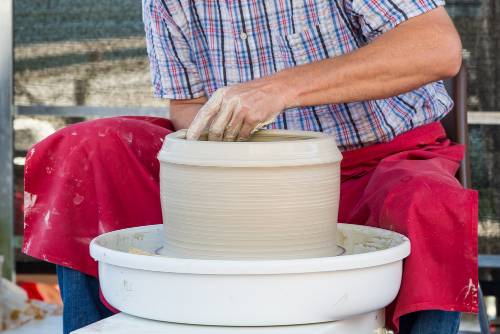
The amount of power that you need your potter’s wheel to have will depend on a few factors. The main factor is the size of the pots you want to make. This leads us to the next point, which is a tip about ‘centering capacity’….
Tip 11) How Much Clay Can It Manage? – Centering Capacity
If you intend to make modest-sized pieces like cups, bowls, and dinner plates, then anything up to ½ hp should be fine.
If you plan to make really large pieces with lots of clay, then ¾ hp or more might be a good idea.
Manufacturers often refer to this as being the centering capacity of the wheel. This refers to the amount of clay that a wheel can cope with before it begins to slow down.
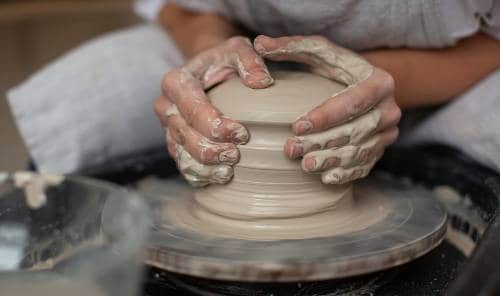
It’s sometimes said that the measurement of ‘centering capacity’ is a bit misleading. The reason for this is that potters throw in different ways.
Some potters use a lot of physical strength when they throw. They center the clay using their strength and body weight. If you are using a lot of strength to center the clay, then the wheel is more likely to slow down.
By contrast, if you rely on techniques that use less strength and muscle, then you are applying less force to the wheel. So, centering capacity is affected by the way a potter uses the wheel.
Nevertheless, the idea of centering capacity can be a handy reference. It can give you an idea of whether a wheel is going to meet your needs as your throwing develops.
Tip 12) Maintenance, Support, and Warranty
Whichever potter’s wheel you buy, you are making an investment, and it’s wise to check out the after-sale support. What is the length of the warranty, and do they offer after-sale support?
If you buy your pottery wheel through local pottery suppliers, they will probably be willing to answer support-type questions.
I’ve found pottery suppliers extremely helpful over the years. If I have a technical question, I give my local supplier a call and they will help out. It’s good to get to know the people in your local pottery suppliers. They can be an invaluable source of help and information.
Tip 13) What Life Span Do You Want?
Are you a complete beginner? Or have you been taking some beginner’s pottery classes?
Maybe you have been taking some classes and you have fallen in love with the potter’s wheel. Perhaps you know that you are at the beginning of a lifelong journey with the potter’s wheel.
If that’s the case, then buying a potter wheel for beginners that costs a little more may be wise. However, you may just be putting your toe in the water to see if you like making pots. If that’s the case, then buying something at the cheaper end of the spectrum would make sense.
This brings me to the final tip about prices….
Tip 14) The Price Tag
Pottery wheels range in price from around $200-2000. When buying a pottery wheel for beginners, it’s good to weigh up the price tag versus the quality of the wheel.
The old adage, “You get what you pay for”, has some merit. However, when it comes to getting a pottery wheel for beginners, you might be surprised to read what I have to say. So, read on…
Choosing a Pottery Wheel for Beginners
Hopefully, these 14 tips will help you assess what might be the best potter’s wheel for you. I’m going to say a bit about 4 wheels which are generally considered a good pottery wheel for beginners.
These are the 4 wheels that I’m going to review:
I thought it might be helpful to say a bit about my first pottery wheel and my experience with it.
The first wheel I bought some years ago was a model supplied by Vevor.
The Vevor 25cm Pottery Wheel
There are quite a few unbranded budget pottery wheels for sale through suppliers like Amazon. It’s hard to know who manufactures these wheels, as they are often unbranded and available through various different sellers.
However, Vevor is a reputable equipment supplier that sells pottery wheels at very competitive prices. Some of these wheels have Vevor branding, others do not.
I’m not sure if the wheels that don’t have the Vevor branding are produced by Vevor or not. What I do know is that it seems to be cheaper to buy a pottery wheel for beginners direct from Vevor than it is to buy through Amazon.
This is the Vevor Potter’s Wheel that I bought and used for some years.
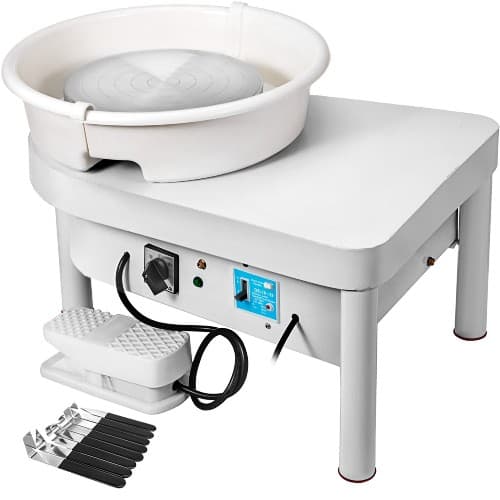
What is it like using this wheel? My experience with the Vevor is that it’s a great pottery wheel for beginners.
It has a smaller motor than most pottery wheels, operating with ¼ hp. However, when you are a beginner, you are learning skills like centering, opening, and pulling up the clay. Most beginner potters start off using smaller quantities of clay. I think the largest amount of clay that I used on the Vevor was around 3lb and it managed just fine with that amount of clay.
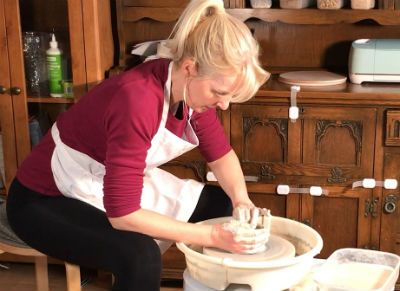
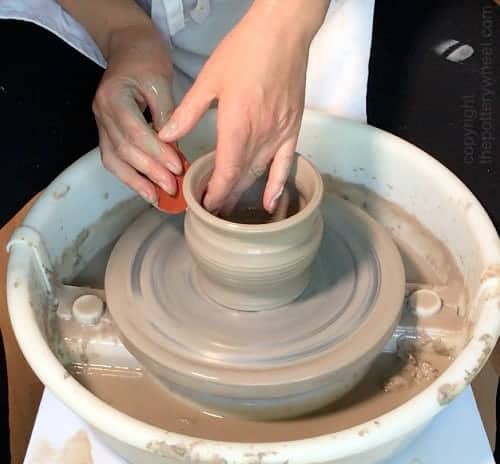
Points about the Vevor Pottery Wheel:
- It has a smaller wheel head than most standard wheels. The wheel head measures up at just under 10”, whereas a standard size is either 12 or 14”.
If you are planning to make large platters this may be an issue. But as a beginner, you are more likely to be learning how to throw modest-sized pieces like mugs, bowls, and vases. - The Vevor does not have bat pins on the wheel head. This means you will need to throw directly onto the wheel head. Or you can buy a BatMate to help you fix the pottery bat to the wheel head.
Personally, I just threw directly onto the wheel head. This is what I was taught to do by my ceramics teacher. And even after using bats for some time, now, I prefer to throw directly onto the wheelhead.
Although having bat pins is handy, they are only strictly necessary if you are throwing much larger pieces. Larger pieces are tricky to lift off the wheel head without a bat. But as a beginner, this most likely won’t be an issue for some time.
- It’s short! The wheel head of a Vevor is just 15” off the ground. If you are very petite or a child, this might be comfortable to use.
But as a relatively tall adult, this was too small for me. I worked around this by putting the 3 legs of the wheel onto bed risers. These are plastic boxes that are designed to lift beds and sofas up a bit higher for older folk.
This solution worked well for me and the wheel height wasn’t an issue going forward.
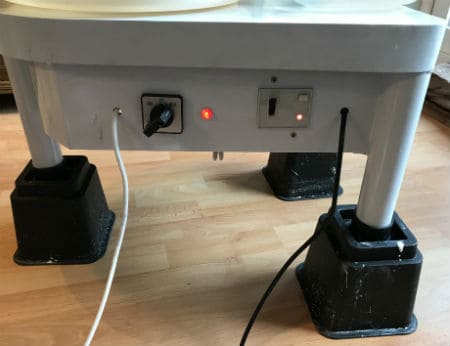
The Vevor Pottery Wheel Specifications
| The Vevor Pottery Wheel | |
| Size (L x W x H) | 22” x 16” x 15.7” |
| Weight | 32.9lb |
| Tabletop/Free-standing | Free-standing |
| Optional Legs | No |
| Wheel Head Diameter | 9.8” |
| Wheel Head Material | Aluminum alloy |
| Bat Pins | No |
| Bat Pin Distance | Not applicable |
| Controls | Foot |
| Reverse Switch | Yes |
| Left / Right Hand | Not applicable |
| Splash Pan | 2 part removable |
| Power | ¼ HP |
| Centering Capacity | 6-7lb |
| Speed (RPM) | 0-300 rpm |
My Verdict on The Vevor Pottery Wheel for Beginners
The Vevor was a great starter wheel for me. At the time I wasn’t able to spend a fortune on a pottery wheel. But I wanted to have something at home to practice on between pottery classes. This pottery wheel for beginners enabled me to learn the basics of throwing at home.
The other good thing about the Vevor is that because it’s compact you can store it easily between pottery sessions. At the time of buying the Vevor, I was making pottery in my living room. I would have to get the pottery wheel out, and put it away at the end of each session. Having something smaller, easy to clean, and store away was essential.
Moving On and Fond Farewells
The Vevor served me very well as a pottery wheel for beginners. I learned a lot and on my first wheel. But like most first loves, that relationship has come to an end.
So, what happened? Well, I grew, and I changed and things just weren’t the same anymore. Actually, to be serious for a moment, after around 3 years, I found that I had outgrown the Vevor. For one thing, I had started to throw larger pieces. But also, as my skills improved on the wheel, I felt I needed a wheel that had a bit more power and torque.
The wheel I was using in class was a Shimpo VL Whisper. I gradually began to feel the difference between using the two wheels. It took me a while to really notice the difference.
So, what did I move on to? For me, it was a toss-up between the Shimpo VL Whisper and the Brent C potter’s wheel. I decided to go with the Brent C. I will say a little more about the Brent C wheel later. But for now, I wanted to stick with wheels that are considered to be a good pottery wheel for beginners who are completely new to pottery.
A good choice as a beginner is a tabletop pottery wheel. These can be a good choice if you are starting out because they are less expensive than most free-standing wheels. But also, because they don’t take up a huge amount of space. Let’s take a look at tabletop pottery wheels now…
Tabletop Pottery Wheels
A tabletop wheel can be a great pottery wheel for beginners for a few reasons. Firstly, they are more affordable than most free-standing pottery wheels.

The two most popular tabletop wheels both make a good pottery wheel for beginners. They are the Shimpo Aspire and the Speedball Artista.
I have a preference for the Shimpo Aspire, so that is the model that I’m going to review now. However, if you want an in-depth comparison of the two, you can check out my post on the Shimpo Aspire and Speedball Artista.
The Shimpo Aspire
The Shimpo Aspire usually costs between $480 and $544. So, whilst this wheel costs more than an entry-level wheel like the Vevor, it is still one of the cheapest wheels on the market.
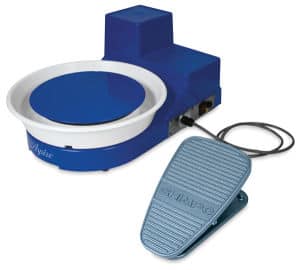
Let’s take a look at what you get with the Shimpo Aspire…
The Basics:
This wheel is very light and weighs only 25lb. The benefit of this is that you can move it around easily and store it out of the way when you aren’t using it. It will fit easily on a shelf when not in use.
In spite of being light, it is solid to use. It has 6 rubber feet on the base that grip well to the tabletop. As a result, the wheel does not slide around as you are throwing your pots.
As well as being light, the Shimpo Aspire is also very compact. It is 20” in length by 14 ½ “ in width. Being so compact is very handy for storage and portability.
However, because the Aspire is more compact, the wheel head is also smaller than usual. The wheel head on most potter’s wheels is either 12 or 14”, with bat pins positioned 10” apart.
By contrast, the wheel head on the Shimpo Aspire is 7” and the distance between the bat pins is 6”. This means that you can’t use standard generic pottery bats on the Shimpo Aspire. You have to buy bats with 6” bat pinholes.
Fortunately, these are easy enough to buy. Of course, Nidec-Shimpo, the makers of the Aspire, make suitable bats. But you can also buy Masonite bats with 6” bat holes from other suppliers such as Dirty Girl.
The bats themselves are just under 10” in diameter. So once the bat is attached, the size of the wheel head increases.
Some Good Things About the Shimpo Aspire
Here are some of the pros about the Shimpo Aspire, which make it a good pottery wheel for beginners.
- It can be operated by hand lever or foot pedal. You can choose whichever controls you prefer or that you are accustomed to. Be aware that you need to say at the point of purchase whether you want a foot pedal or hand lever control. However, if you buy a hand lever version and change your mind, you can buy and install a foot pedal at a later date.
- For a compact wheel the Shimpo Aspire is quite powerful. It has a 1/3 HP motor and can comfortably center up to 20lb of clay. To make a large mug you need up to 2lb of clay. So, being able to center up to 20lb of clay is more than enough for most potters who are starting out.
- The Shimpo Aspire is a good option if you want to take your pottery wheel on holiday or do alfresco demonstrations. The Aspire has a 100-watt motor, which you can plug into a 400-watt inverter. This can then be plugged into the lighter socket of a car. This means that if you feel like practicing your throwing skills in the outdoors, you are good to go.
- Another benefit of the Shimpo Aspire is that it is easy to clean. The splash pan is made in one piece. When you remove the bat, you can lift the splash pan right over the wheel head in one piece. It can then be easily cleaned, before reinstalling it and turning it to lock it back into place.
The Shimpo Aspire Specifications
| The Shimpo Aspire | |
| Size (L x W x H) | 20 x 14.5 x 9” |
| Weight | 25lb |
| Tabletop/Free-standing | Tabletop |
| Optional Legs | No |
| Wheel Head Diameter | 7” |
| Wheel Head Material | Alloy |
| Bat Pins | Yes |
| Bat Pin Distance | 6” |
| Controls | Foot or Hand |
| Reverse Switch | No |
| Left / Right Hand | Yes |
| Splash Pan | 1 part removable |
| Power | 1/3 HP |
| Centering Capacity | 20lb |
| Speed (RPM) | Hand Lever 0-230 rpm Foot Pedal 0-250 rpm |
Things to Be Aware of With the Shimpo Aspire
The Shimpo Aspire is a very good pottery wheel for beginners. However, there are features to be aware of if you choose to buy one. These are:
- The motor on the Shimpo Aspire is positioned on the top left-hand side of the wheel. The position of the motor means that you can’t make very wide platters on the Shimpo Aspire.
The reason for this is that the casing for the motor gets in the way of very wide pieces. If you plan to move onto really wide flatter pieces, then the Shimpo Aspire may not be right for you. - It’s also good to be aware that the Shimpo Aspire doesn’t have a reverse function. You can’t just flick a switch and reverse the direction that the wheel head spins.
This really isn’t much of an issue for most potters. However, it’s just important to know that you will need to specify when you buy your pottery wheel, which direction you want the wheel head to turn.
If you are very new, it is probably a good idea to take a class locally and find out which rotation feels more comfortable. Then you will be able to choose the direction of your wheel with confidence when you buy.
The Shimpo VL Whisper
The second Shimpo model that I want to talk about is the Shimpo VL Whisper. I don’t own one of these wheels, but I do use one in the local ceramics studio. When I was upgrading from my first wheel, I seriously considered buying the Shimpo VL, because I love it.
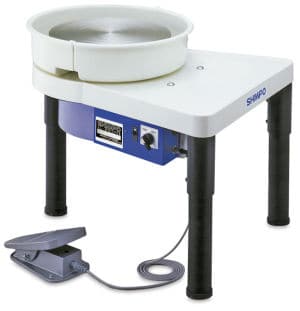
Here is what I love about the Shimpo VL Whisper and why I think it’s a good pottery wheel for beginners…
- It feels really solid and well made. But it also has quite a refined light feel too. Although they are solid and strong, they don’t feel chunky and big.
- They are tidy and have modest proportions, so they don’t take up a lot of space. And they are easy to store.
- You can remove the legs and put some rubber caps on the bottom of the wheel. This means it can be used as a tabletop wheel if you want to, which is very handy.
- To me, the Whisper feels like a sensitive wheel. The foot pedal is responsive, and you can adjust the speed of the wheel by minute amounts. What’s more, once you’ve set the wheel at the speed you want, it feels very smooth.
- When the wheel head is at 0rpm, it rotates freely and can be used as a banding wheel. This is handy for spot-checking your pots, and also for applying glaze, underglaze, or terra sigillata.
- As the name suggests, the Whisper is extremely quiet.
Let’s talk about Power
I’ve read some reviews of the Shimpo VL Whisper that say it lacks torque. Lacking torque means that it slows down when it’s working hard with a lot of clay or a lot of pressure.
However, my experience of the Whisper is that it has plenty of power. It has a ½ hp motor and it feels strong when you are using it.
It is true that I generally make medium-sized pots. The largest amount of clay I have used is probably around 5lb.
So, perhaps I haven’t challenged the VL Whisper enough. It may be that the Whisper slows down with very large quantities of clay. But, I haven’t experienced that. My own experience with the Whisper is that it feels strong and responsive.
In fact, the Whisper does seem to divide opinion. Some owners absolutely love them and believe they are the best of all possible wheels. And there are those who say they can lack torque under pressure.
I’m not sure why they divide opinions like that, but I can say that I love using the Shimpo VL Whisper.
| Shimpo VL Whisper | |
| Size (L x W x H) | 27 ½ x 23 1/8 x 22 ¾ |
| Weight | 120lb |
| Tabletop/Free-standing | Free-standing |
| Optional Legs | Adjustable Legs |
| Wheel Head | 14” |
| Wheel Head Material | Light alloy casting |
| Bat Pins | Yes |
| Bat Pin Distance | 10” |
| Controls | Foot |
| Reverse switch | Yes |
| Splash Pan | 2 part removable |
| Power | ½ HP |
| Centering Capacity | 100lb |
| Speed (RPM) | 0-250 rpm |
You may be asking, if I love the Shimpo VL Whisper so much, why didn’t I buy one. Well, for me it was a toss-up between the Shimpo VL Whisper and the Brent C pottery wheel. And in the end, I decided on the Brent C. Here is why…
The Brent C Pottery Wheel
Of the 4 pottery wheels that I’m reviewing here, the Brent C has the most powerful motor. It has a ¾ hp motor, which is probably more than I’m ever going to need.
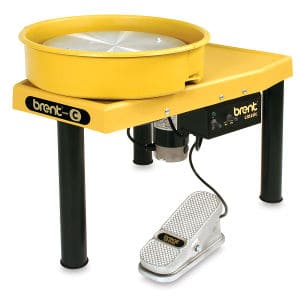
But in addition to being powerful, the Brent C motor is responsive. The motor will detect when there is an increase in pressure on the wheel and will automatically increase its power output. This stops the wheel from slowing down, as you apply pressure when you are throwing.
Another feature of the Brent C wheel is that it is a belt-drive arrangement. Now, I’m not pretending to know much at all about motors, but what I do know is that most pottery wheels are belt-driven. By contrast, the VL Whisper is a direct drive motor. I had read that belt drive motors are easier to maintain and fix.
Honestly, I’m not a mechanic, and I’m not 100% sure if it is easier to fix a belt drive motor. But I had read in a few places that this was the case. And ultimately it was a combination of the power, responsiveness, and belt drive set up that tipped me in favor of the Brent C.
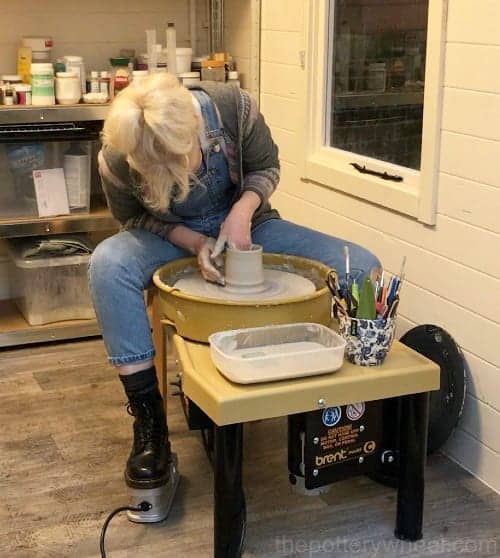
And I have to say I’m very happy with my choice for these reasons…
Things I Love About the Brent C
It feels very solid and sturdy to throw on.
The pedal is sensitive and it’s easy to control the speed of the wheel. I’ve used wheels before where the speed of the wheel head will suddenly leap up with small pressure on the pedal. But the speed of the Brent C is smooth and gradual.
As mentioned before, the motor is responsive. So, the wheel head doesn’t slow down as you apply pressure to your pottery.
The splash pan is easy to remove and clean but also locks in place nice and snugly. So, it doesn’t wobble as you throw and I find it doesn’t leak either.
It comes with a plastic bat. I have to say, it has taken me some time to get used to throwing on a bat. With my first wheel, I threw directly on the wheel head. And in fact, I throw on the wheel head in class too. Throwing on a bat is different and it felt like I had to learn how to center again. But now I’m used to it, it does make life easier.
You can buy leg risers and booties to adjust the height of the wheel. I find it’s the right height for me as it is. But it’s good to have the option.
Lastly, it comes with a 10-year warranty, which is reassuring.
| The Brent C Pottery Wheel | |
| Size (L x W x H) | 28 x 21 x 21 ½ “ |
| Weight | 121 lb |
| Table Top/Free-standing | Free-standing |
| Optional Legs | Extending booties |
| Wheel Head | 14” |
| Wheel Head Materials | Cast aluminum |
| Bat Pins | Yes |
| Bat Pin Distance | 10” |
| Controls | Foot |
| Reverse switch | Yes |
| Splash Pan | 2 part removable |
| Power | ¾ PH |
| Centering Capacity | 225lb |
| Speed (RPM) | 0-240 rpm |
Is the Brent C a Good Pottery Wheel for Beginners?
The Brent C pottery wheel is not the cheapest pottery wheel on the market. In fact, out of the 4 I’ve talked about, it carries the highest price ticket, costing around $1560. However, it is a good investment and feels like a ‘forever / lifetime’ potter’s wheel.
But is it a good pottery wheel for beginners? I would say that if you are a complete beginner then this probably is not the wheel for you. If you have never used a pottery wheel before, you may find when you try it that you don’t enjoy it. Buying a pricier wheel only to realize you don’t like throwing pots is an expensive mistake.
However, if you have been taking a pottery class for months and you know you love it, then it might be worth the investment.
Alternatively, perhaps you are in that transition from beginner to intermediate and want to take your pottery to the next level. If you are at that point where you are committed to throwing pots, then this is a good pottery wheel for beginners.
Final Thoughts
If money is no object, then I’d say each of the above wheels would be a good pottery wheel for beginners.
However, the reality is that most of us have a budget. If you are absolutely new to pottery, and you don’t want to splurge, I’d suggest the Vevor or the Shimpo Aspire.
Of course, there is a big difference in the prices of those two pottery wheels. And your budget will likely determine which of those pottery wheels you could stretch to.
If you’ve been making pottery for a while and you are sure you want to pursue it in the future, then either the Shimpo VL Whisper or the Brent C is great.
I hope you’ve found this guide to the best pottery wheel for beginners helpful. Keep potting!



